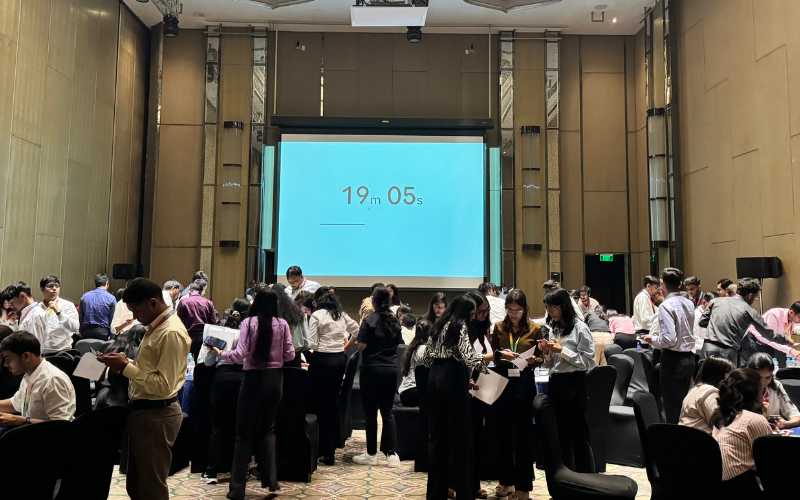The Future of Recruitment Events: Engaging Candidates with Simulations
In today’s fast-paced, technology-driven world, recruitment events are evolving rapidly. Traditional methods still hold value, but they’re being enhanced, and in some cases, replaced by more innovative approaches. One method gaining significant traction is the use of simulations in recruitment events.
This blog explores how simulations are shaping the future of recruitment, their benefits, and why they are becoming an essential tool for organisations seeking top talent.
Introduction
Recruitment events have always been a crucial part of talent acquisition strategies. They offer a platform for employers to connect with potential candidates, showcase their company culture, and assess candidates’ skills and suitability for various roles. However, as the job market becomes increasingly competitive, employers are seeking more effective ways to engage candidates and ensure a better fit.
The Rise of Simulations in Recruitment
Simulations are interactive scenarios that mimic real-world tasks or situations relevant to the job role. They allow candidates to demonstrate their skills, problem-solving abilities, and behavioural traits in a controlled environment. This method offers a more immersive and accurate assessment of a candidate’s potential compared to traditional interviews or assessments.
Benefits of Using Simulations in Recruitment Events
1. Enhanced Candidate Engagement
Simulations transform the recruitment process from a passive experience into an interactive one. Candidates are more likely to be excited and interested when participating in a simulation, leading to a more enjoyable and memorable experience. Engaged candidates are also more likely to perform at their best, providing a clearer picture of their capabilities.
2. Realistic Skill Assessment
Simulations provide a realistic environment where candidates can demonstrate their skills and problem-solving abilities. Unlike traditional interviews that often rely on hypothetical questions, simulations allow candidates to engage in tasks and scenarios they would encounter in the actual job. This results in more accurate and reliable assessments of their abilities and potential fit for the role.
3. Improved Diversity and Inclusion
Reducing unconscious bias is a significant advantage of using simulations. By focusing on candidates’ performance in realistic scenarios, employers can make more objective decisions based on actual abilities rather than subjective impressions. This approach helps create a more diverse and inclusive workforce, levelling the playing field for all candidates regardless of their background.
4. Faster Decision-Making
Simulations provide immediate insights into a candidate’s suitability for a role, allowing employers to make quicker and more informed decisions. The ability to swiftly identify top talent and move forward in the recruitment process can significantly reduce the time-to-hire, ensuring exceptional candidates are not lost to competitors.
5. Enhanced Candidate Experience
A positive candidate experience is crucial for employer branding. Simulations offer a unique and engaging recruitment process that can leave a lasting impression on candidates. Even if they are not ultimately selected for the role, candidates who have had a positive experience are more likely to speak favourably about the organisation, enhancing its reputation in the job market.
6. Identification of Soft Skills
Soft skills, such as communication, teamwork, and adaptability, are often challenging to assess through traditional methods. Simulations can effectively highlight these skills by placing candidates in scenarios that require collaboration, quick thinking, and effective communication. This comprehensive evaluation helps employers identify candidates with the right blend of technical and interpersonal skills.
7. Better Cultural Fit
Assessing cultural fit is essential for long-term employee satisfaction and retention. Simulations can be designed to reflect the company’s values, culture, and typical workplace scenarios. By observing how candidates respond to these situations, employers can gauge whether they align with the company’s culture and values, ensuring a better fit.
8. Increased Confidence in Hiring Decisions
Making informed hiring decisions is critical to building a strong team. The detailed insights gained from simulations provide a solid foundation for these decisions. Employers can feel more confident that they are selecting candidates who not only have the required skills but also demonstrate the right behaviours and attitudes for success in the role.
9. Cost-Effectiveness
While the initial investment in simulation technology may seem high, the long-term benefits often outweigh the costs. Improved hiring accuracy, reduced turnover, and faster time-to-hire contribute to overall cost savings. Additionally, a more efficient and effective recruitment process can lead to better organisational performance and productivity.
10. Continuous Improvement
Simulations offer opportunities for continuous improvement in the recruitment process. By collecting data and feedback from both candidates and assessors, organisations can refine their simulations to better meet their needs. This iterative approach ensures that the recruitment process remains relevant, effective, and aligned with organisational goals.
Implementing Simulations in Recruitment Events
1. Define Objectives and Scenarios
- Identify Clear Objectives: Understand what you aim to achieve with simulations, such as evaluating specific technical skills, behavioural traits, or cultural fit.
- Design Relevant Scenarios: Scenarios should mirror real-world tasks and challenges pertinent to the role. For example, if hiring for a customer service position, create scenarios that test problem-solving and communication skills in a customer interaction context.
2. Choose the Right Technology
- Evaluate Technology Platforms: There are various software solutions available, each offering different levels of interactivity and customisation. Popular platforms include Mursion, Immerse, and Virti.
- Consider Features and Budget: Ensure the chosen platform meets your organisation’s needs, looking for features like ease of use, scalability, and detailed reporting capabilities. Balance these requirements with your budget constraints.
3. Develop Comprehensive Training Programmes
- Train Recruiters and Assessors: Ensure those administering the simulations are well-trained, understanding both the technical aspects of the platform and best practices for evaluating performance.
- Create Standardised Evaluation Criteria: Develop a clear framework for assessing candidates, with specific, measurable criteria aligned with job requirements to ensure consistency and objectivity.
4. Pilot the Simulations
- Conduct a Pilot Programme: Before full-scale implementation, run a pilot programme with a small group of candidates to identify potential issues and allow for adjustments.
- Collect Feedback: Gather feedback from both candidates and recruiters to refine the simulation scenarios and improve the overall process.
5. Integrate Simulations into the Recruitment Process
- Promote the Simulations: Inform potential candidates about the simulation process as part of your recruitment marketing, highlighting benefits like a more engaging and fair assessment.
- Seamless Integration: Ensure the simulation is a natural part of the recruitment process, complementing other assessment methods unless simulations alone are sufficient.
6. Monitor and Evaluate
- Continuous Monitoring: Regularly review the effectiveness of the simulations, tracking metrics such as candidate performance, time-to-hire, and feedback scores.
- Adjust and Improve: Use data and feedback to make necessary adjustments to the simulations, such as tweaking scenarios, updating technology, or revising evaluation criteria.
7. Ensure Legal and Ethical Compliance
- Data Privacy: Handle all candidate data collected during simulations in compliance with data protection regulations like GDPR.
- Fairness and Accessibility: Ensure simulations are accessible to all candidates, including those with disabilities, and designed to prevent any form of discrimination.
Practical Steps and Tips
- Define Role Requirements Clearly: Ensure simulations are relevant and targeted by understanding the role requirements.
- Utilise Realistic and Challenging Scenarios: Ensure scenarios are realistic and challenging enough to differentiate between candidates’ skill levels effectively.
- Provide Candidates with Instructions and Support: Make sure candidates understand the process and what’s expected of them, providing support and answering questions.
- Use a Blend of Assessment Methods: Combine simulations with other assessment methods like interviews and psychometric tests for a more holistic view of the candidate.
- Communicate Feedback to Candidates: Provide constructive feedback based on candidates’ performance in the simulations, enhancing their experience and leaving a positive impression of your organisation.
FAQs
Q: Are simulations suitable for all types of roles?
A: While simulations are highly effective for many roles, particularly those requiring specific technical skills or problem-solving abilities, they may not be suitable for all positions. Assess whether a simulation will provide valuable insights for the particular role you’re hiring for.
Q: How do candidates typically respond to simulations?
A: Most candidates find simulations a refreshing and engaging change from traditional recruitment methods. They appreciate the opportunity to demonstrate their skills in a realistic setting and often feel simulations provide a fairer assessment of their abilities.
Q: Are simulations expensive to implement?
A: The cost of implementing simulations can vary depending on the complexity of the scenarios and the technology platform used. However, the long-term benefits, such as improved hiring accuracy and reduced time-to-hire, often outweigh the initial investment.
Real Facts and Statistics
- Increased Hiring Accuracy: According to a study by the Harvard Business Review, companies using simulations in their recruitment process see a 25% increase in hiring accuracy.
- Positive Candidate Feedback: A survey conducted by LinkedIn found that 68% of candidates had a more favourable view of companies using simulations in their recruitment process.
- Reduction in Time-to-Hire: Organisations utilising simulations report a 30% reduction in time-to-hire, as simulations provide immediate insights into candidates’ abilities.
What’s Next?
As we move forward, organisations must continually innovate and adapt their recruitment strategies. Simulations represent a significant leap in this direction, offering a more engaging, precise, and inclusive method to evaluate candidates. By incorporating simulations into your recruitment events, you can enhance your hiring outcomes and establish your organisation as a forward-thinking employer of choice.
MDA Training can support you in this transformative journey. Our team of experts specialises in developing and implementing cutting-edge simulation-based recruitment solutions tailored to your specific needs. Get in touch with MDA Training today for a demo and discover how our innovative approach can meet your training needs and elevate your recruitment process.



















